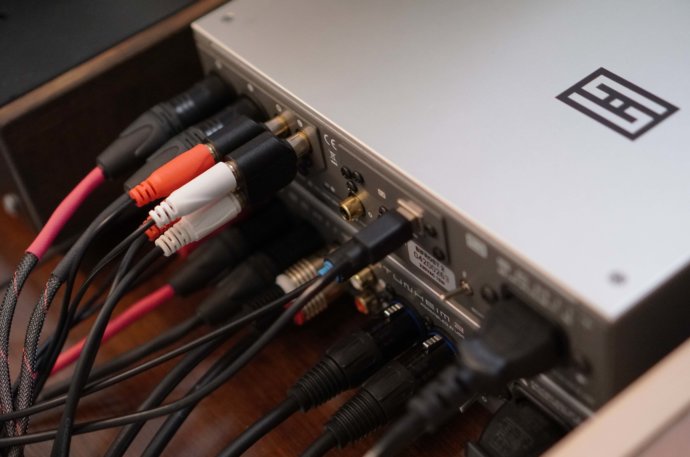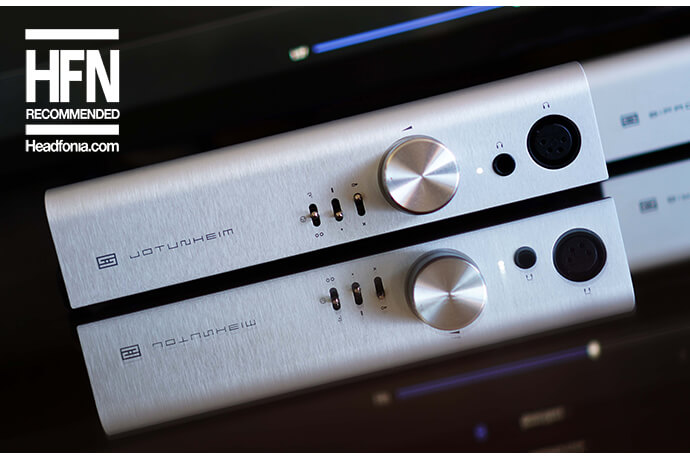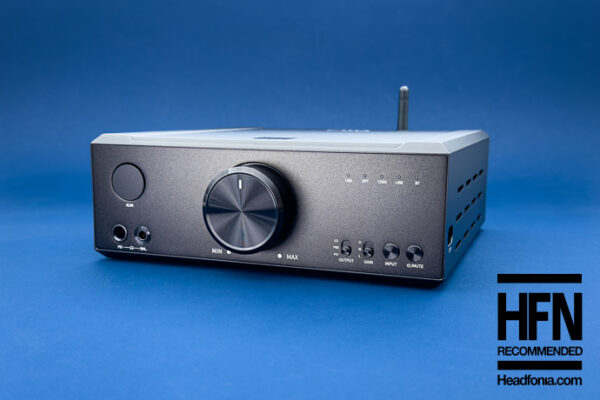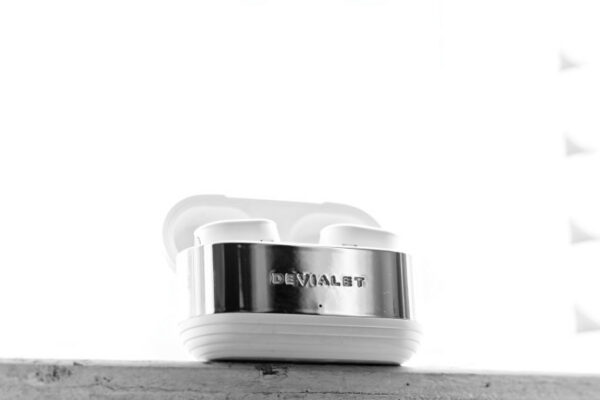User experience
The Jotunheim 2 is a pretty simple device to get up and running out of the box. Schiit will ship it to you with your country’s IEC power cord of choice as well as a short, pun-filled manual. Yes, there’s no chunky wall-wart going on here – the Jotunheim’s onboard power supply means you can plug any old cord into it (or even a really expensive one if that’s your jam) and off you go. Flick the rear-mounted power switch “on”, and you’re greeted with a white LED light on the top to let you know that the Jotunheim is ready for business. Well, not quite – I got a little confused the first couple of times that I listened to the Jotunheim, because no sound was coming out. I initially thought I’d wired things incorrectly, but after about ten seconds, there’s a small ‘click’ inside the device and music starts playing. It’s not a big deal, but it’s just something that you need to get used to. Unlike its Class-A biased sibling the Asgard 3, the Jotunheim never really gets that warm to the touch when in operation. If you don’t have anything stacked on top of the Jotunheim, you’ll be treated to the nice warm glow of some orange LEDs inside the chassis that are visible through the vent holes to remind you that it’s “on”.
The Jotunheim 2 will take up to three different inputs: single-ended RCA, balanced XLR, and in this case, RCA phono inputs. These inputs are controlled by the left-hand three-position toggle switch on the front of the unit and makes the Jotunheim 2 a super flexible device. Being able to switch between a turntable, CD player, and DAC without needing to switch out cables is a godsend for the way I generally have things set up on my desktop. Adding to this, the Jotunheim’s digital sister device, the Bifrost 2, can take three digital inputs (USB, coaxial, optical) and so can give the Jotunheim up to six different inputs. And with a FLAC library, Xbox console and CD transport thrown into the mix, you can bet that it’s easily possible to make the most out of every single one of them.

However, with three sets of analogue inputs (including the phono stage) and two analogue outputs, things can naturally get a little crowded on the back of the Jotunheim 2 – especially if it’s stacked with the Bifrost and its associated cables!
The headphone output of the Jotunheim 2 is ‘always on’ and will send a signal out of both inputs at all times, with two gain settings controllable via the middle toggle on the front of the device – “up” = high, “down” = low. The gain control also changes the level of preamp signal being sent to downstream devices, which can now be controlled by that newer third switch on the device. Flicking it “up” turns the preamp signal on, which makes for a much more convenient and elegant solution than simply unplugging your headphones. I tested the Jotunheim 2 in preamp mode feeding both a subwoofer and power amp, and it performed flawlessly in this setup. In fact, the Jotunheim 2/Bifrost 2 stack makes for a formidable DAC/preamp combo in a two-channel setup thanks to its cornucopia of inputs and outputs – the only thing really holding it back from being a genuine replacement for dedicated hifi components is the lack of a remote…which might not be a problem for you. Seriously, it’s that good.
Sitting back on my couch listening to vinyl via my Rega turntable, and then seamlessly sliding into some digital streaming via Roon with the flick of a switch was pretty awesome. However, I’m certain that most of you are probably more likely to use the Jotunheim in a headphone setup, and that’s definitely where its chief talents lie.
Who’s this device suitable for?
So before we get hit “play” and feed the Jotunheim 2 with some music, it’s worth thinking about who will be interested in this kind of device, and what they need it for. The most obvious thing that the Jotunheim 2 has going for it is power. As in, it has a lot of it on tap – a potential 7.5 Watts into 16 ohms, in fact. Now we all know that we’ll never use close to that amount of power to get most headphones to normal listening levels, but the key selling feature here is headroom – or, power in reserve, and the ability to avoid clipping and underpowering a transducer. Owners of notoriously insensitive headphones like the Hifiman HE6, which has a sensitivity rating of 83dB should take note – the Jotunheim 2 can crank out a whole 4 Watts at the HE6’s impedance rating of 50 ohms. So while that amount of power shouldn’t really matter to most of you, it’s good to know that you have future proof power available with your amplifier, and the Jotunheim certainly has that.
The other reason for opting for the Jotunheim 2, is the ability to run a fully balanced signal chain, and plug-in balanced headphone cable into the front of the amp. The Jotunheim 2 isn’t one of those devices that has XLR facilities for mere convenience – it’s a truly differential balanced amplifier. Feed is with either a balanced or a single-ended source, and the signal emerges truly balanced, Schiit explains – there’s no internal conversion taking place. What this means for would-be owners, is that they can make full use of balanced source gear, keeping a balanced signal chain intact from end-to-end, making use of the benefits of noise rejection and improved channel separation. It also means that you’re able to make full use of that 7.5 Watts of power from the 4-pin XLR jack!
But, flexibility is also the name of the game here – if you’re buying an amplifier to sit on your desk for many years to come, it’ll need to do more than simply be “really loud”. So we most certainly want to make sure that the Jotunheim 2 has some more tricks up its sleeve, and is able to tango with all sorts of headphones…as well as making music enjoyable to listen to.
Click over to page 3 to continue the review.








Apurve
Hi matty
very nice review. Quite descriptive of what is on offer and what to expect.
I see you paired the Jot with Planars and got a good result. I’m thinking of getting the Jot for Arya’s and HD6XX.
With Arya’s, the punch and dynamics the jot seems like a great match. However, I suspect that the brightness uptop may be a bit too much? What wud be your assessment?
With 6xx also, while the power will help drive it accurately, and the slight sparkle uptop may help lift the Senn veil, I wonder if the sound signature may be too warm in the low end making the hp sound bloated? Would you say that is a fair assessment?
If one is only looking to get a headamp an use it single ended, how far behind a s the Asgard in terms of sound quality, especially w.r.t staging and resolution?
Both will be fed by Bifrost 2 upstream.
Love to hear your thoughts!
Matty Graham
Thanks for reading and taking the time to comment mate.
I actually haven’t heard the Arya for some time, so I couldn’t give you an accurate idea of how it’d work, sorry.
My HD650’s are on loan to a friend at the moment, but when they’re back in the house I’ll update the article and let you know.
Paul
I have 3 failed Schiit devices for no reasons. I’d advise to stay away as it is not a good investment. Test your J2 for a long time…
Ali Arghavan
Hi Matty, thanks for the review
Since you have reviewed both the Jot 2 and Playmate 2, which are both in similar price range (If you configure Jot2 with optional DAC) which one do you recommend? I plan to use them with ZMF Aeolus and DCA Aeon 2 Noire
Steve
Just ordered one last week, I’m going to pair it with an AresII DAC.